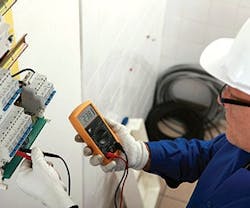Green Supers Boost Efficiency at Multifamily Facilities
New York City residential rental rates are among the highest in the world, and a green certification program aims to squeeze the utmost efficiency out of those buildings.
The Green Supers program is a cooperative effort between property managers, city superintendents, and 32BJ, a property services union affiliated with the Service Employees International Union (SEIU). It entails a 40-hour course and satisfactory performance on both written and field exams.
Upon completion, Green Supers also earn certification as Urban Green Council Green Professionals (GPRO) and Building Performance Institute (BPI) Multifamily Building Operators.
“With 77% of our city’s greenhouse gas emissions generated by buildings, we must all work together to protect the environment,” says 32BJ President Mike Fishman. “Making the Big Apple green starts with recognizing the vital role of building service workers.”
The Green Super program curriculum is comprised of the following 10 units:
- Building Science & Building Envelope
- Lighting
- HVAC
- Field Exercise: Mechanical Room & Roof
- Sustainability/Indoor Environmental Quality
- Water Conservation
- Field Exercise: Hallway, Lobby, Apartment
- Utilities & Energy Benchmarking
- Green Building Work Plan
- Review & Practice Exam
“What really makes a building efficient is the people running it,” says Patrick Long, 32BJ member and manager of a Manhattan building. “If we are going to make buildings more efficient, workers need to understand green technologies and practices, learn new skills, and maintain complex equipment.”
In 2010, the U.S. Department of Labor granted the Thomas Shortman Training Fund $2.8 million to expand the Green Supers program. It aims to train 2,200 NYC superintendents. The grant is part of a $500 million Recovery Act initiative to fund workforce development projects that promote economic growth by preparing workers for careers in energy efficiency and renewable energy industries.
“By expanding Green Supers, more building workers will learn how to air seal a building, improve HVAC performance, and reduce overall energy use in a building’s common areas,” says Linda Nelson, director of the fund.
Now, over 1,000 NYC buildings are run by Green Supers and 95% of them have implemented energy efficiency projects within a year of graduation, according to a collaborative study by 32BJ and Steven Winter Associates.
Of those projects, 71% included new lighting, 45% incorporated HVAC installations, and 34% involved envelope system upgrades. Results from the buildings’ energy audits indicate that the projects are making progress for the buildings, with 35% qualifying as “energy efficient” according to industry standards and 41% as performing average.
At a panel discussion hosted by the Urban Green Council and 32BJ, it was revealed that Green Supers training is not only making improvements in buildings, but also in the lives of workers.
“My position is no longer just a job, but part of an overachieving goal to make things better,” says Victor Nazario, manager of the Whitney at 311 E. 38th St. “It’s part of my personal legacy.”
Green Supers are making strides on their career paths as well as in building efficiency, says Marat Olfir, manager of the Future Condominiums at 200 E. 32nd St. “Being a Green Super has helped me get better jobs in good buildings,” he says.
For more information, visit www.1000supers.com.
